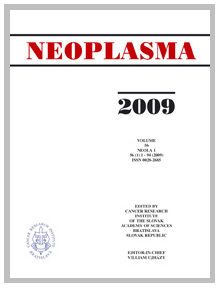Journal info
|
||
Select Journal
Journals
Bratislava Medical Journal Ekologia - Ecology Endocrine Regulations General Physiology and Biophysics Neoplasma 2025 Ahead of print 2024 2023 2022 2021 2020 2019 2018 2016 2017 2015 2014 2013 2012 2011 2010 2009 2008 2007 2006 2005 2004 2003 Acta Virologica Studia Psychologica Cardiology Letters Psychológia a patopsych. dieťaťa Kovove Materialy-Metallic Materials Slovenská hudba 2025Webshop Cart
Your Cart is currently empty.
Info: Your browser does not accept cookies. To put products into your cart and purchase them you need to enable cookies.
Neoplasma Vol.70, No.1, p. 71–81, 2023 |
||
| Title: CBX3 promotes breast cancer progression and high level of CBX3 predicts poor prognosis in patients | ||
| Author: Kai Yang, Ya-Lin Wang, Zhen Zhu, Xin-Hui Cao, Ming-Xing Liang, Di Xu, Yin-Jiao Fei, Si-Yuan Yang, Hong-Lei Zhou, Jin-Hai Tang | ||
| Abstract: Breast cancer is one of the leading cancer deaths around the world. Targeted drugs have greatly increased the survival rate of breast cancer patients in recent years. But in some patients, the current regimen is still ineffective. Therefore, more therapeutic targets for treating breast cancer are demanding. The core heterochromatin-related genes of breast cancer were identified by utilizing prognostic survival analysis and multivariate Cox hazard proportional regression analysis. Both breast cancer and adjacent normal tissue were collected and analyzed with western blot and immunohistochemistry. Colony formation assay, CCK8 assay, and EdU assay were used to measure the effect of CBX3 on breast cancer cell growth, wound-healing assay and Transwell assay were used to analyze the effect of CBX3 on breast cancer cell migration and invasion. Flow cytometry assay and western blot were used to study the molecular mechanism of CBX3 in breast cancer. High expression of heterochromatin-related proteins CBX3, H2AFY, and SULF1 showed a poor prognosis in patients in both TCGA dataset and GEO datasets. Western blot demonstrated that the expression level of CBX3 was significantly higher in breast cancer than that in adjacent normal tissues. Colony formation assay, CCK8 assay, and EdU assay showed that the knockdown of CBX3 could significantly inhibit breast cancer cell growth, and the overexpression of CBX3 could promote the growth of breast cancer cells. Transwell assay and wound healing assay showed that knockdown of CBX3 inhibited breast cancer cell migration and invasion, and the overexpression of CBX3 promoted breast cancer cell migration and invasion. Western blot showed that CBX3 might promote breast cancer cell proliferation, invasion, and migration in breast cancer by modulating the ERK1/2 signaling pathway and epithelial-mesenchymal transition (EMT)-related genes. CBX3 was a biomarker of poor prognosis in breast cancer patients. CBX3 promoted the proliferation of breast cancer cells through the ERK signaling pathway, and migration and invasion of breast cancer cells through EMT-related genes. The CBX3/p-ERK1/2 signaling axis might provide a new therapeutic method against breast cancer. |
||
| Keywords: breast cancer; CBX3; TCGA; proliferation; invasion | ||
| Published online: 09-Jan-2023 | ||
| Year: 2023, Volume: 70, Issue: 1 | Page From: 71, Page To: 81 | |
| doi:10.4149/neo_2022_220622N656 |
||
|
|
 download file download file |
|

